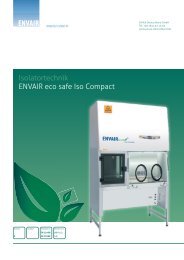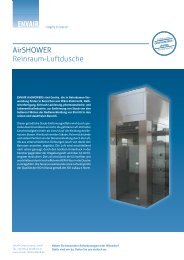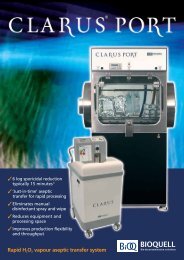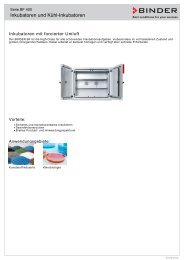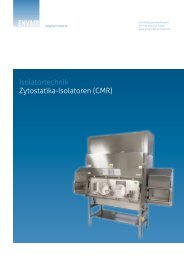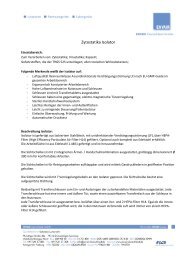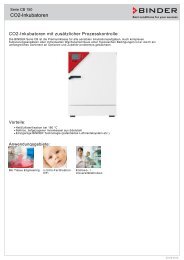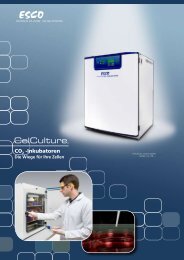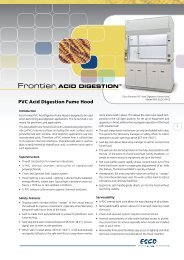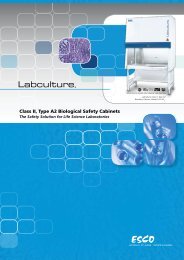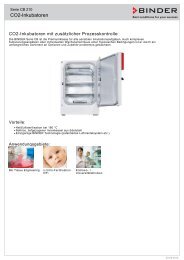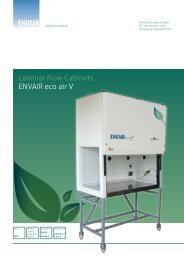Appendix 1 - - ENVAIR Deutschland
Appendix 1 - - ENVAIR Deutschland
Appendix 1 - - ENVAIR Deutschland
You also want an ePaper? Increase the reach of your titles
YUMPU automatically turns print PDFs into web optimized ePapers that Google loves.
<strong>Appendix</strong> 1 -<br />
Equipment Specifications & Descriptions<br />
1.1 Clarus TM PORT Rapid Gassing System<br />
The industry has identified a need to achieve very rapid<br />
bio-decontamination cycles for small loads for aseptic<br />
processing in isolator enclosures as the time for surface<br />
decontamination of product enclosures is a rate limiting<br />
factor for overall processing capacity.<br />
A configuration has been identified where a rapid<br />
decontamination chamber attached to process isolators<br />
can maintain continuous processing capacity by<br />
achieving at least two load decontamination cycles per<br />
hour, providing the load represents at least one hour of<br />
processing time. In recognition of this Bioquell has<br />
developed the Clarus PerOxide Rapid Transfer (PORT)<br />
System to fulfil these processing requirements.<br />
The Clarus PORT can also be used as a double-ended<br />
rapid bio-decontamination pass through chamber to<br />
surface sterilise and transfer materials into cleanrooms.<br />
The PORT System bio-decontamination chamber is<br />
manufactured from stainless steel with toughened glass<br />
doors and vision panels.<br />
The unit has a full front glass opening panel which is<br />
hinged upwards and secured on gas struts to assist with<br />
opening and closing. Each end of the chamber is fitted<br />
with a circular door on an interface housing onto which<br />
an isolator can be attached. The rear of the chamber is<br />
fitted with a fixed glass panel to provide light from the<br />
room and to provide vision through the chamber. Within<br />
the gassing chamber is located a product load trolley<br />
mounted on a rail system which can transfer either to<br />
the left or right for unloading.<br />
Above the decontamination chamber is mounted the gas distribution system comprising the<br />
unique active rotating distribution nozzle and the control system and display panel. The<br />
ventilation system is housed below the chamber. Supply and exhaust air is fully HEPA filtered.<br />
A catalytic filter system is fitted on the exhaust air from the chamber to remove all traces of<br />
hydrogen peroxide vapour before the air stream is then HEPA filtered and supplied back into<br />
the chamber. A separate diaphragm pump is used for pressure control of the chamber during<br />
the aeration phase until the sterilised load is transferred into the isolators.<br />
The doors are clear toughened glass with an inflatable seal around the perimeter to ensure a<br />
full air seal and also to act as an interlock when the door is closed. In addition the door has a
mechanical latch that will prevent accidental opening of the door in the unlikely event of loss of<br />
compressed air supply.<br />
The gas generator (Clarus L2) is normally located at one end of the chamber. It is connected<br />
to the PORT System by gas supply and return hoses, a communication cable and chamber<br />
pressure sensor hose. The operation of the Clarus L2 generator controls and the PORT System<br />
are fully integrated when the generator is docked. Cycle status is displayed on the PORT<br />
controls, together with any warning or alarm condition. All generator commands are displayed<br />
at the generator and printed reports are output on the gas generator printer. The sterilisation<br />
cycle can be initiated either from the gas generator or from the PORT control panel.
Loading door open<br />
Transfer trolley
Technical Specification<br />
Materials of External<br />
Construction<br />
: Chamber – 316L stainless steel<br />
Lower plenum – PVC<br />
Windows and doors – toughened glass<br />
Operating<br />
Temperature<br />
:<br />
:<br />
15°C - 35°C (For successful & repeatable decontamination)<br />
5°C to 40°C (Safe to operate)<br />
Relative<br />
Humidity<br />
Operating<br />
Storage<br />
:<br />
:<br />
85% RH maximum<br />
95% RH (non condensing)<br />
Power requirement : AC 220 – 240V 50 Hz (Euro) 6amp<br />
Power consumption<br />
: 1250W<br />
Dimensions<br />
(WxHxD)<br />
External<br />
Chamber<br />
:<br />
:<br />
1214 x 1966 x 798<br />
1050 x 715 x 615<br />
Maximum H 2 0 2 liquid volume<br />
: 175 ml (Two bottle sizes with a range of fills)<br />
Typically 10 ml is required<br />
H 2 0 2 Liquid<br />
: 30-35% w/w or 60% w/w<br />
Interface flange : Door aperture 559mm x 430mm<br />
Control System<br />
: Siemens S7 PLC<br />
(Software compliant with GAMP)<br />
Airflow rate<br />
Aeration<br />
:<br />
750 cu.m /hr<br />
Set back<br />
:<br />
200 cu.m/hr<br />
H 2 O 2 evaporation rate<br />
: 3.8 g/min<br />
HEPA filter efficiency : 99.997%<br />
Pressurisation System range<br />
Catalytic filters<br />
: 0 to +100 Pa<br />
: Activated carbon
Noise<br />
: Less than 55 dBA at 1 metre (free field)<br />
Design and Specification subject to change without notice
1.2 Clarus TM L2 Hydrogen Peroxide Vapour Generator<br />
• ‘Dual Circuit’ technology for optimum cycle times<br />
• Closed circuit operation – no external vent required<br />
• Siemens MP177 colour touch screen<br />
• GAMP compliant software<br />
• Compact and highly portable design<br />
• Easily cleanable external surface<br />
• Volt free contacts for external signals<br />
• Integral thermal paper printer<br />
• Remote start/stop<br />
• Simple connection, flexible supply / return hoses and<br />
pressure monitoring<br />
• Supply and return hoses (2m long)<br />
• Cycle edit and store facility for new applications<br />
• Effective against a wide range of micro-organisms<br />
• Hydrogen Peroxide gas sensor<br />
• RH sensor<br />
• Utilises 30 % w/w or 60% AnalaR grade H 2<br />
O 2<br />
in standard<br />
format containers (500 mL or 1000mL)<br />
• Maximum enclosure bio-decontamination 80m 3<br />
• Dimensions: 510(w) x 700(d) x 1135(h) mm.<br />
• Weight: 80Kg
Technical Specification<br />
External materials of construction :<br />
Temperature – Operating<br />
- Storage<br />
Relative Humidity – Operating<br />
- Storage<br />
Power requirement / Consumption :<br />
:<br />
:<br />
Operating position<br />
Dimensions (WxHxD) – Open<br />
Shipping carton<br />
Weight<br />
Maximum H202 liquid volume<br />
H202 Liquid concentration<br />
Gas hoses<br />
Gas hose connections<br />
Control system<br />
Airflow rate – Gassing<br />
:<br />
:<br />
:<br />
:<br />
:<br />
Top cover – polypropylene<br />
Side panels – polyurethane coated aluminium<br />
15°C to 30°C<br />
-15°C to 50°C<br />
75% RH maximum<br />
85% RH at 38°C maximum<br />
AC 220 – 240V 50 Hz (Euro),6 Amp<br />
AC 110 – 120V 60 Hz (USA),12 Amp<br />
AC 91 – 110V 50/60 Hz (Japan),12 Amp<br />
: Upright only<br />
: 510 x 1135 x 700mm<br />
600 x 1250 x 810mm<br />
: 80 kg, Gross shipping weight 100kg<br />
: Up to 1000 ml<br />
: 30-60% w/w<br />
: 25mm I/D x 2m long<br />
: 1.5” male/female Camlock fittings<br />
: Siemens S7 PLC (software compliant with GAMP)<br />
: 25m 3 /hr<br />
- Conditioning/aeration : Greater than 25m 3 /hr at 800Pa external pressure<br />
Pressure available at outlet<br />
: 1200Pa<br />
Temperature of supply gas at outlet : Greater than 50°C to 75°C<br />
H202 liquid injection rate<br />
Refrigeration System off coil<br />
Temperature<br />
Condensate removal<br />
Inlet air HEPA filter efficiency : 99.99%<br />
Circuit A and B HEPA filter efficiency : 99.99%<br />
Pressurisation System flow rate<br />
Pressurisation System range<br />
Catalytic filters<br />
: Approximate 2 - 6g/min<br />
: Approx. 2°C (from 20°C return)<br />
: Evaporation to atmosphere<br />
: 100 l/min (max)<br />
: -70Pa to -10Pa, +10Pa to +70Pa<br />
: Carbon
Noise level<br />
Enclosure decontamination capacity<br />
: Less than 60dBa at 1 metre<br />
: Up to 75m 3 (subject to configuration and loading)<br />
Design and Specification subject to change without notice
1.3 Isolator Direct Injection System<br />
The Direct Gas Injection system comprises of a series of assemblies designed to work in<br />
conjunction with the Clarus TM gas generator to bio-decontaminate Isolators by direct injection.<br />
The assemblies allow a standard Clarus TM unit to inject Hydrogen Peroxide directly into the<br />
isolator work chamber through a distribution nozzle.<br />
Gas Distribution Dynamic Nozzle,<br />
Part No. TS290-1000<br />
A unique patented system for effective gas<br />
distribution in isolators or awkward geometries<br />
is available. H 2 O 2 vapour is delivered to the<br />
motorised nozzle, rotating in single fixed speed<br />
axis, releasing gas at a high velocity. The high<br />
energy and turbulence created by the nozzle<br />
system effectively distributes the hydrogen<br />
peroxide vapour over all surfaces.<br />
motor assembly that is<br />
located externally to the<br />
chamber<br />
being<br />
decontaminated. The nozzle<br />
is supplied with a 1½”BSP<br />
male parallel thread as<br />
standard. (shown here with<br />
triclover<br />
adapter<br />
H16030035 attached) The<br />
nozzle has a switch that<br />
provides a feedback signal<br />
to indicate that the nozzle is<br />
rotating.<br />
The distribution nozzle comprises of a<br />
detachable head that can be configured for the<br />
specific chamber volume and geometry. The<br />
main body of the nozzle includes a 24V DC
Typical Distribution Nozzle Head<br />
Part No. TS290-1200<br />
The appropriate distribution nozzle head will be specified<br />
by Bioquell Engineering / Validation department<br />
according to the application and will be added to the<br />
sales order as a separate line item. In a typical singlenozzle<br />
application, the TS290-1200 is used.
1.4 Pressure Control Connection<br />
As the Clarus L2 has a pressure control function, it is necessary to provide a pressure<br />
monitoring point on the enclosure. If no suitable connection is currently fitted, we recommend<br />
the use of a self-sealing connector, with a quick-connect function.<br />
Part No. H16010057<br />
Typical pressure connection. One to be fitted to each discrete<br />
chamber<br />
Coupling Body, Bulkhead panel mount, hose barb - valved<br />
¼” flow, with shut off valve<br />
- Hole size – 18mm<br />
- Part No. H16010034<br />
Coupling insert in-line hose barb, ¼” tubing ID, straight<br />
through no valve, to be fitted to Clarus TM pressure control<br />
hose<br />
1.5 Sampling Connection<br />
Part No. H16030004 Swagelok Quick-Connect Body<br />
Part No. H16030005 Swagelok Quick-Connect Hose Coupling<br />
Part No. H16030006 Swagelok Quick-Connect Stem
The three items shown are used together with a sampling device (e.g. Portasens or Drager<br />
hand-pump) to allow measurement of the vapour concentration in the enclosure to determine<br />
the true end-point of the decontamination cycle. The sampling device (E.g. Portasens, below)<br />
may be connected to the Hose Coupling using a short piece of plastic tube. This is then locked<br />
into the Stem, which opens the sampling valve when inserted into the Body. The hole size<br />
required for fitting the body into the enclosure wall is 12mmDia.
1.6 Gas Detection<br />
PortaSens C16 - Hand Held Low Level H2O2 Gas Detector<br />
Part No. H19010003 (Universal Voltage)<br />
Low-level gas leak detection is an important part of every plant safety program. Biodecontamination<br />
with Hydrogen Peroxide as a process requires the use of a potentially toxic<br />
gas, with the OEL typically less than 1 ppm. Such a hazard can be managed through careful<br />
equipment maintenance and regular monitoring for early signs of low-level leakage.<br />
• Internal sample pump and external sample wand<br />
• One-handed pistol grip design<br />
• Standard "D" cell battery and rechargeable backup battery<br />
• Easy to read back-lit graphics liquid crystal display<br />
• Instantaneous and timed-sampling modes of operation<br />
• Visual and Audible alarms<br />
• Internal data-logger with RS-232 output<br />
The C16 hand held portable gas leak detector is a versatile tool for performing regular<br />
instantaneous low level leak checks. Designed for easy one-hand operation, the detector<br />
contains an internal sample pump and a flexible sampling wand to allow pinpoint location of<br />
the source of possible H 2 O 2 leakage. A large character display insures that measured values<br />
are easily visible, and a backlight for the display insures readability in low or no light<br />
conditions.



